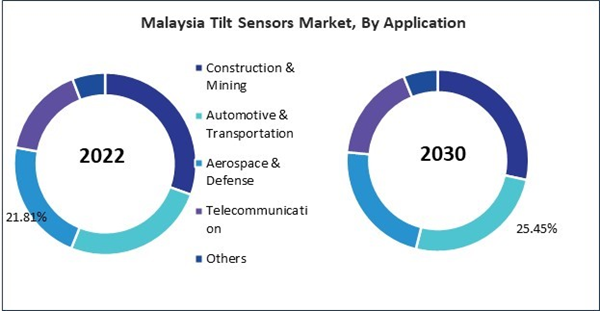Micro-Electro-Mechanical Systems (MEMS) technology revolutionizes these sensors by miniaturizing mechanical and electrical components on a microscopic scale. In MEMS sensors, microstructures like beams or cantilevers with integrated piezoelectric or capacitive elements respond to changes in tilt. These sensors utilize silicon-based manufacturing processes, allowing for compact, lightweight, and cost-effective designs. Therefore, the China market consumed 1,061.5 thousand units of Solid State (MEMS) sensors in 2022.
The China market dominated the Asia Pacific Tilt Sensors Market by Country in 2022, and would continue to be a dominant market till 2030; thereby, achieving a market value of $42,525.8 Thousands by 2030. The Japan market is registering a CAGR of 7.7% during (2023 - 2030). Additionally, The India market would showcase a CAGR of 9.2% during (2023 - 2030).
These sensors are crucial in manufacturing and industrial automation applications. They are used in robotic arms, CNC machines, and assembly lines for precise positioning, orientation, and alignment of components and equipment. These sensors enable automation systems to perform tasks with accuracy and repeatability, improving efficiency and quality in manufacturing processes.
Additionally, these sensors are integrated into smartphones, tablets, gaming consoles, and wearable devices for screen orientation detection, gesture recognition, and motion-based interactions. In smartphones and tablets, these sensors adjust screen orientation based on device tilt, providing a seamless user experience. These sensors enable motion-based gaming and activity-tracking features in gaming controllers and wearable devices.
According to the International Trade Administration data, the focal points of China’s 14th Five-Year Plan are new urbanization, energy, transportation, and water systems infrastructure initiatives. Based on estimations, the cumulative investment in new infrastructure throughout the 14th Five-Year Plan (2021-2025) is anticipated to approximate 27 trillion yuan ($4.2 trillion). Furthermore, as per the National Investment Promotion & Facilitation Agency, the telecom industry in India is the second largest in the world, with a subscriber base of 1.182 Bn as of October 2023 (wireless + wireline subscribers). India has an overall tele density of 84.79%. Hence, the increasing expenditure in construction and expansion of the telecommunication sector in the region is driving the market’s growth.
Based on Material Type, the market is segmented into Non-Metal and Metal. Based on Technology, the market is segmented into Solid State (MEMS), Fluid-Filled, and Force Balanced. Based on Application, the market is segmented into Construction & Mining, Automotive & Transportation, Aerospace & Defense, Telecommunication and Others. Based on countries, the market is segmented into China, Japan, India, South Korea, Singapore, Malaysia, and Rest of Asia Pacific.
List of Key Companies Profiled
- The Fredericks Company
- Balluff GmbH
- Baumer Holding AG
- Sick AG
- IFM Electronics GmbH
- Jewell Instruments, LLC
- Meggitt PLC (Parker Hannifin Corporation)
- Murata Manufacturing Co., Ltd.
- TE Connectivity Ltd.
- Robert Bosch GmbH
Market Report Segmentation
By Material Type (Volume, Thousand Units, USD Million, 2019-2030)- Non-Metal
- Metal
- Solid State (MEMS)
- Fluid-Filled
- Force Balanced
- Construction & Mining
- Automotive & Transportation
- Aerospace & Defense
- Telecommunication
- Others
- China
- Japan
- India
- South Korea
- Australia
- Malaysia
- Rest of Asia Pacific
Table of Contents
Companies Mentioned
- The Fredericks Company
- Balluff GmbH
- Baumer Holding AG
- Sick AG
- IFM Electronics GmbH
- Jewell Instruments, LLC
- Meggitt PLC (Parker Hannifin Corporation)
- Murata Manufacturing Co., Ltd.
- TE Connectivity Ltd.
- Robert Bosch GmbH









